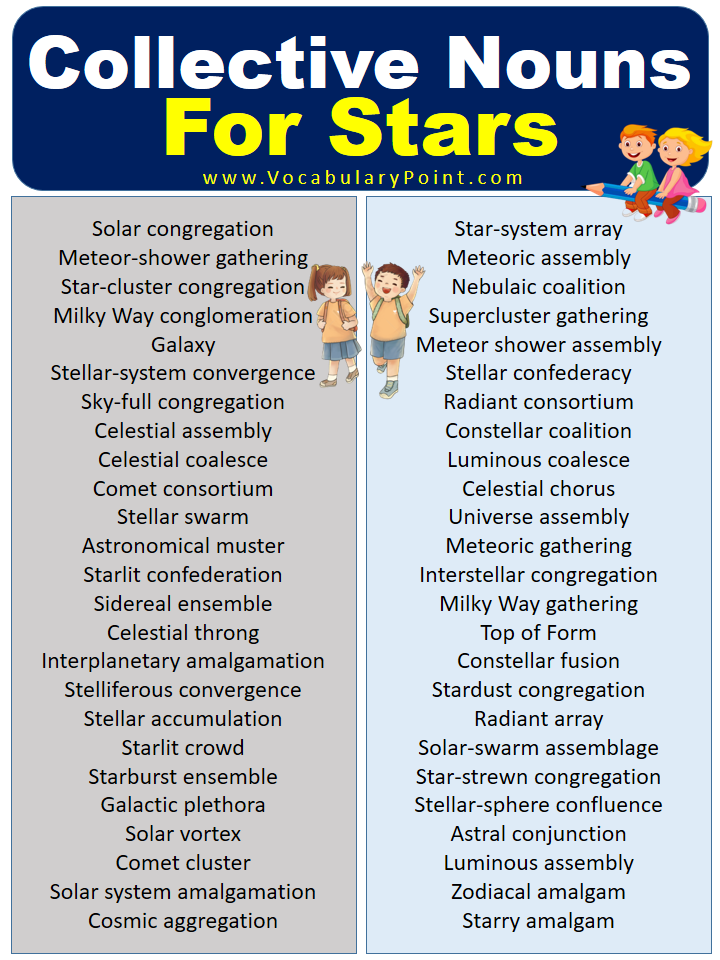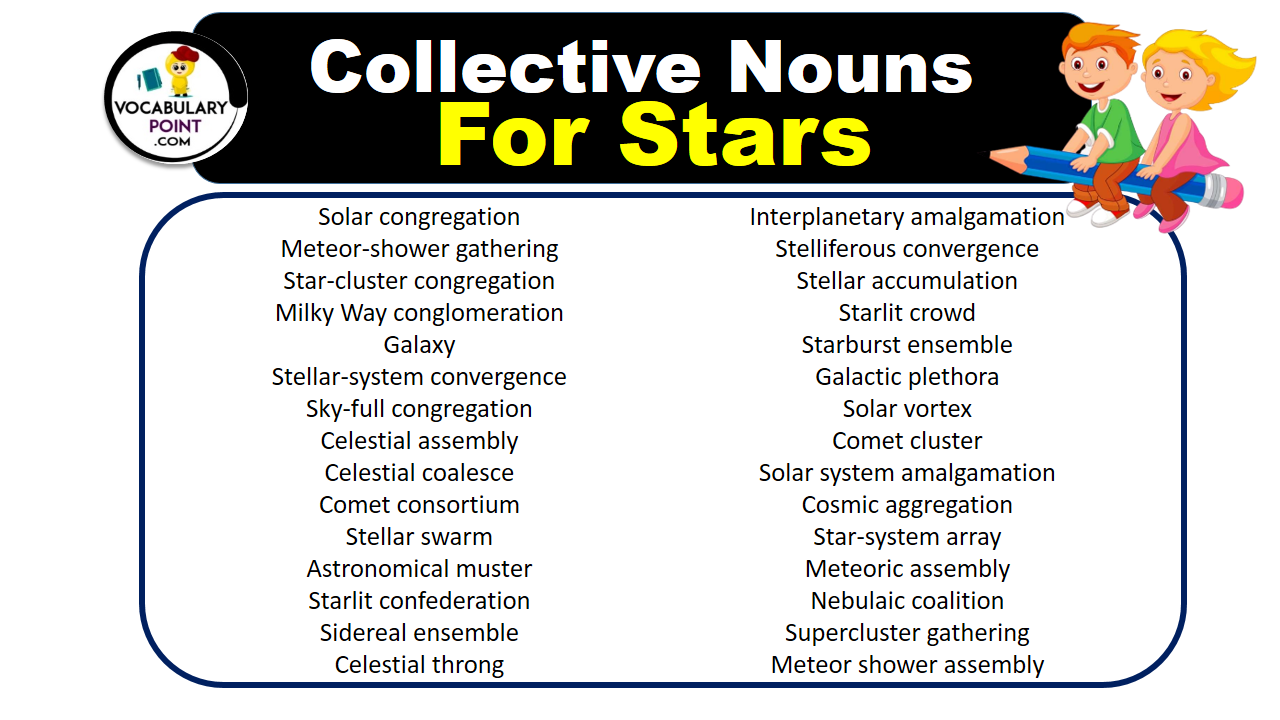Stars have captivated human imagination for centuries, with their twinkling beauty and mysterious nature. As we gaze up at the night sky, it is easy to get lost in the vast expanse of stars that seem to go on forever. But have you ever wondered what a group of stars is called? Just like animals or people, stars also have collective nouns to describe them when they come together in clusters or patterns. In this article, we will explore some interesting collective nouns used for stars, unraveling their meanings and providing fascinating examples from the celestial world. So join us as we embark on an enlightening journey into the language of the cosmos!
What is the Collective Noun For Stars?
The collective noun for stars is “galaxy.” A galaxy is a vast system of stars, star clusters, gas, dust, and other celestial objects bound together by gravity. There are billions of galaxies in the universe, each containing millions to trillions of stars. The Milky Way, for example, is the galaxy in which our solar system resides.
Here are the 10 Collective Nouns For Stars:
- Constellation
- Cluster
- Nebula
- Celestial assembly
- Stellar congregation
- Galaxy
- Stellar swarm
- Starry multitude
- Radiant array
- Astral gathering
Collective Nouns For Stars
- Solar congregation
- Meteor-shower gathering
- Star-cluster congregation
- Milky Way conglomeration
- Galaxy
- Stellar-system convergence
- Sky-full congregation
- Celestial assembly
- Celestial coalesce
- Comet consortium
- Stellar swarm
- Astronomical muster
- Starlit confederation
- Sidereal ensemble
- Celestial throng
- Interplanetary amalgamation
- Stelliferous convergence
- Stellar accumulation
- Starlit crowd
- Starburst ensemble
- Galactic plethora
- Solar vortex
- Comet cluster
- Solar system amalgamation
- Cosmic aggregation
- Star-system array
- Meteoric assembly
- Nebulaic coalition
- Supercluster gathering
- Meteor shower assembly
- Stellar confederacy
- Radiant consortium
- Constellar coalition
- Luminous coalesce
- Celestial chorus
- Universe assembly
- Meteoric gathering
- Interstellar congregation
- Milky Way gathering
- Top of Form
- Constellar fusion
- Stardust congregation
- Radiant array
- Solar-swarm assemblage
- Star-strewn congregation
- Stellar-sphere confluence
- Astral conjunction
- Luminous assembly
- Zodiacal amalgam
- Starry amalgam
- Galactic parade
- Star-dance ensemble
- Comet conglomeration
- Nebulous rendezvous
- Sidereal coalescence
- Astral accumulation
- Celestial host
- Nebula
- Cosmic plethora
- Stardust symphony
- Sidereal galaxy
- Sky-full communion
- Star-studded consortium
- Nebulous conclave
- Astral assembly
- Starry fellowship
- Universe union
- Planetary parade
- Solar-swirl assembly
- Radiant convergence
- Astral gathering
- Galactical array
- Star-cloud collective
- Stellar chorus
- Interstellar assembly
- Interstellar cluster
- Stardust assortment
- Star-flurry gathering
- Starry commune
- Nebulous assemblage
- Interstellar multitude
- Nebulaic rendezvous
- Solar-system cohort
- Star-cloud assembly
- Cosmic accumulation
- Nebular commune
- Interplanetary gathering
- Celestial consort
- Celestial congregation
- Galactical conflux
- Cluster
- Stellar congregation
- Sidereal amalgamation
- Starry multitude
- Nebular multitude
- Celestial coherency
- Constellar assembly
- Celestial amalgamation
- Zodiacal assembly
- Constellation
Must Read: Collective Nouns For Stairs

Collective Nouns For Stars With Meaning and Examples
- Galaxy:
Meaning: A massive system of stars, gas, dust, and other celestial objects bound together by gravity.
Example:
- The Andromeda Galaxy is a spiral galaxy visible from Earth.
- Our solar system is located in the Milky Way Galaxy.
- The Hubble Space Telescope has captured breathtaking images of distant galaxies.
- Constellation:
Meaning: A group of stars that form a recognizable pattern when viewed from Earth.
Example:
- Orion is a prominent winter constellation in the night sky.
- The Big Dipper is a well-known constellation in the Northern Hemisphere.
- The Southern Cross is a famous constellation in the Southern Hemisphere.
- Cluster:
Meaning: A group of stars that are physically close to each other and gravitationally bound.
Example:
- The Pleiades is an open star cluster easily visible to the naked eye.
- The Beehive Cluster (M44) is a beautiful group of stars in the constellation Cancer.
- The globular cluster Omega Centauri contains millions of stars tightly packed together.
- Nebula:
Meaning: A cloud of gas and dust in space, often illuminated by nearby stars.
Example:
- The Orion Nebula is a stellar nursery where new stars are born.
- The Helix Nebula is a planetary nebula with a striking appearance.
- The Crab Nebula is the remnant of a supernova explosion observed in the year 1054.
- Stellar Congregation:
Meaning: A gathering or assembly of stars.
Example:
- In the vastness of space, there are countless stellar congregations.
- Astronomers study the evolution of stellar congregations to understand star formation.
- The telescope revealed a previously unknown stellar congregation in the distant galaxy.
- Astral Gathering:
Meaning: A collection or assembly of stars.
Example:
- On a clear night, the sky is adorned with a dazzling astral gathering.
- The festival took place under the brilliance of an astral gathering.
- Ancient cultures attributed mystical meanings to certain patterns in the astral gathering.
- Stellar Array:
Meaning: An ordered arrangement or display of stars.
Example:
- The telescope’s powerful lens revealed a stunning stellar array of distant stars.
- The artist skillfully depicted a beautiful stellar array in the painting.
- The astronomer documented the changing patterns of stars in the stellar array.
- Celestial Ensemble:
Meaning: A harmonious grouping or collection of stars in the celestial sphere.
Example:
- The night sky showcased a mesmerizing celestial ensemble of stars and planets.
- The astronomer admired the grandeur of the celestial ensemble through the telescope.
- The mythological tales often associated gods and heroes with specific celestial ensembles.
- Stardust Assembly:
Meaning: A poetic term referring to the gathering of stars and cosmic matter.
Example:
- In the vast expanse of the cosmos, we find a magnificent stardust assembly.
- The philosopher contemplated the origins of life in the context of the stardust assembly.
- The telescope allowed us to glimpse the secrets hidden within the stardust assembly.
- Sidereal Union:
Meaning: A cosmic union or association of stars.
Example:
- The ancient astronomers believed that the gods resided in the sidereal union of stars.
- The planetarium provided a captivating show on the mysteries of the sidereal union.
- Modern astrophysicists explore the dynamics of the sidereal union in distant galaxies.
- Stellar Swarm:
Meaning: A large group or collection of stars, often tightly packed together.
Example:
- The globular cluster Messier 13 is a dazzling stellar swarm in the constellation Hercules.
- The telescope captured a distant stellar swarm consisting of young, hot stars.
- The galaxy NGC 602 contains a vibrant stellar swarm of newly formed stars.
- Cosmic Assembly:
Meaning: A gathering or congregation of stars on a cosmic scale.
Example:
- The Hubble Space Telescope provided stunning images of a cosmic assembly of galaxies.
- The vastness of the universe contains countless cosmic assemblies of stars and galaxies.
- Astronomers study the distribution of matter in the universe through large-scale cosmic assemblies.
- Starlit Conflux:
Meaning: A meeting or convergence of stars, creating a luminous spectacle.
Example:
- The meteor shower resulted in a breathtaking starlit conflux of shooting stars.
- Under the clear night sky, the starlit conflux of stars and constellations was a sight to behold.
- The ancient skywatchers marveled at the regular starlit conflux of planets and stars.
- Celestial Host:
Meaning: A vast gathering or multitude of stars in the celestial realm.
Example:
- The Milky Way Galaxy hosts a myriad of stars in its celestial host.
- The astronomer pointed the telescope towards the celestial host in a distant galaxy.
- Legends often refer to the celestial host as celestial beings watching over the world.
- Nebulaic Rendezvous:
Meaning: An encounter or gathering of stars within a nebula.
Example:
- The Orion Nebulaic Rendezvous is a fascinating region where stars are born.
- The Hubble Space Telescope observed a rare nebulaic rendezvous of stars in the Carina Nebula.
- The study of nebulaic rendezvous provides insights into the processes of star formation.
- Starry Commune:
Meaning: A peaceful gathering or community of stars, evoking a sense of togetherness.
Example:
- Looking up at the night sky, one can feel a connection with the starry commune
- Ancient civilizations believed the stars formed a celestial starry commune influencing human destinies.
- Astronomers explore the chemistry of stars within a starry commune to understand their evolution.
- Galactical Array:
Meaning: An organized or ordered arrangement of stars within a galaxy.
Example:
- The study of the galactical array in the Andromeda Galaxy reveals its spiral structure.
- Observations of the galactical array help astronomers understand the distribution of stars.
- The galactical array in the Triangulum Galaxy showcases its vast stellar population.
- Astronomical Muster:
Meaning: A large and impressive gathering or collection of stars, akin to an astronomical spectacle.
Example:
- The telescope revealed an astronomical muster of stars in a distant galaxy.
- The meteor shower created an astronomical muster of shooting stars visible from Earth.
- The observation deck provided a breathtaking view of the astronomical muster of stars.
- Radiant Congregation:
Meaning: A gathering or assemblage of stars emitting a radiant glow.
Example:
- The Pleiades is a radiant congregation of stars that shines brightly in the night sky.
- The radiant congregation of stars in the Milky Way is a celestial wonder.
- The astronomer studied the radiant congregation to understand the evolution of stars.
- Stellar Chorus:
Meaning: A poetic reference to the collective harmony and beauty of stars in the sky.
Example:
- As night fell, a stellar chorus of stars began to paint the sky with twinkling lights.
- The artist depicted a celestial scene with a stellar chorus of stars and constellations.
- The astronomer marveled at the brilliance of the stellar chorus during a dark sky observation.
